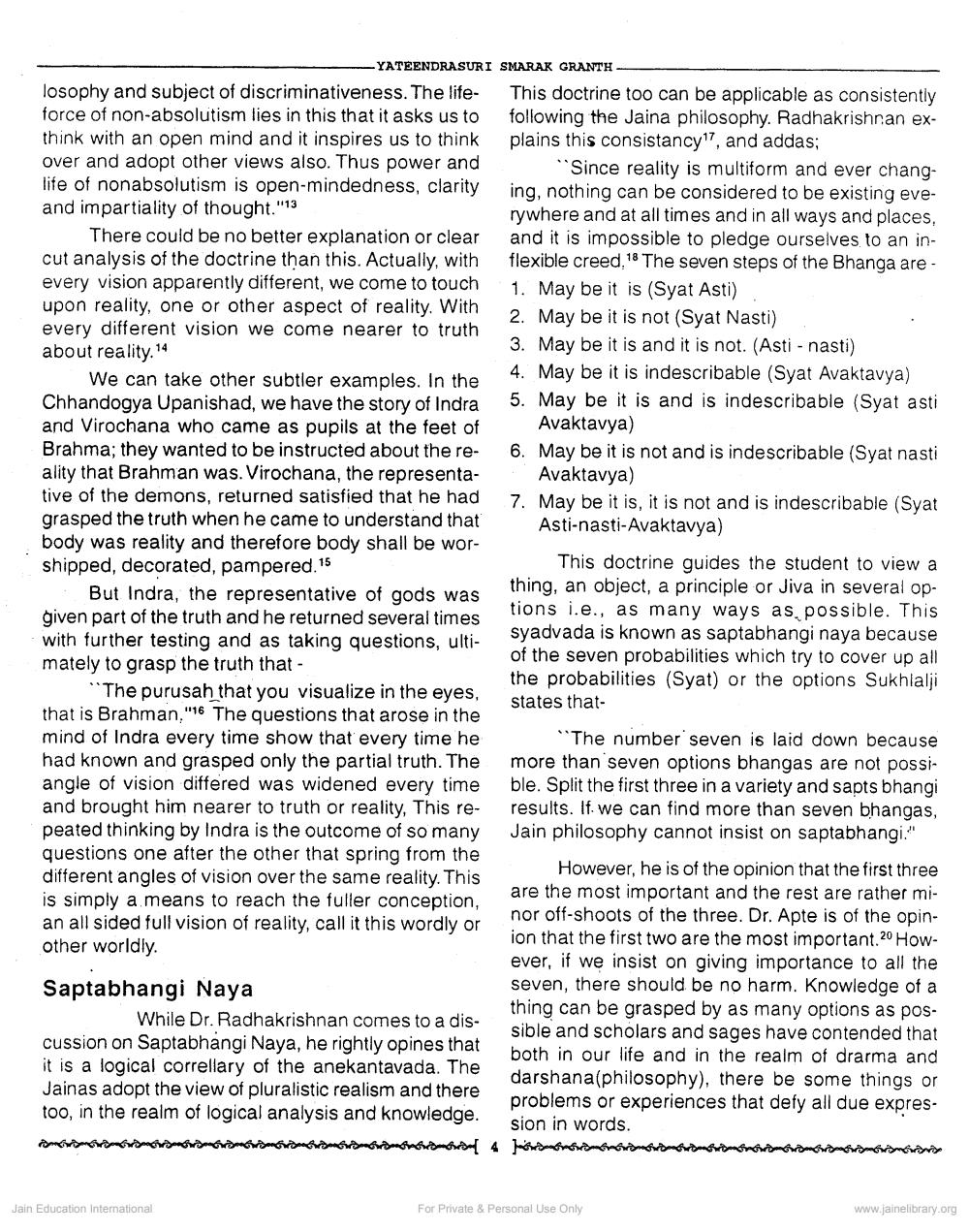________________
YATEENDRASURI SMARAK GRANTH
losophy and subject of discriminativeness. The lifeforce of non-absolutism lies in this that it asks us to think with an open mind and it inspires us to think over and adopt other views also. Thus power and life of nonabsolutism is open-mindedness, clarity and impartiality of thought."""
There could be no better explanation or clear cut analysis of the doctrine than this. Actually, with every vision apparently different, we come to touch upon reality, one or other aspect of reality. With every different vision we come nearer to truth about reality."4
We can take other subtler examples. In the Chhandogya Upanishad, we have the story of Indra and Virochana who came as pupils at the feet of Brahma; they wanted to be instructed about the reality that Brahman was. Virochana, the representative of the demons, returned satisfied that he had grasped the truth when he came to understand that body was reality and therefore body shall be worshipped, decorated, pampered.15
But Indra, the representative of gods was given part of the truth and he returned several times with further testing and as taking questions, ultimately to grasp the truth that
"The purusah that you visualize in the eyes, that is Brahman, "16 The questions that arose in the mind of Indra every time show that every time he had known and grasped only the partial truth. The angle of vision differed was widened every time and brought him nearer to truth or reality, This repeated thinking by Indra is the outcome of so many questions one after the other that spring from the different angles of vision over the same reality. This is simply a means to reach the fuller conception, an all sided full vision of reality, call it this wordly or other worldly.
Saptabhangi Naya
While Dr. Radhakrishnan comes to a discussion on Saptabhangi Naya, he rightly opines that it is a logical correllary of the anekantavada. The Jainas adopt the view of pluralistic realism and there too, in the realm of logical analysis and knowledge.
Ge6d[ 4
Jain Education International
This doctrine too can be applicable as consistently following the Jaina philosophy. Radhakrishnan explains this consistancy17, and addas;
"Since reality is multiform and ever chang ing, nothing can be considered to be existing everywhere and at all times and in all ways and places, and it is impossible to pledge ourselves to an inflexible creed, 18 The seven steps of the Bhanga are - 1. May be it is (Syat Asti)
2.
May be it is not (Syat Nasti)
3.
May be it is and it is not. (Astinasti)
4.
May be it is indescribable (Syat Avaktavya) 5. May be it is and is indescribable (Syat asti Avaktavya)
6. May be it is not and is indescribable (Syat nasti Avaktavya)
7. May be it is, it is not and is indescribable (Syat Asti-nasti-Avaktavya)
This doctrine guides the student to view a thing, an object, a principle or Jiva in several options i.e., as many ways as, possible. This syadvada is known as saptabhangi naya because of the seven probabilities which try to cover up all the probabilities (Syat) or the options Sukhlalji states that
"The number seven is laid down because more than seven options bhangas are not possible. Split the first three in a variety and sapts bhangi results. If we can find more than seven bhangas, Jain philosophy cannot insist on saptabhangi."
However, he is of the opinion that the first three are the most important and the rest are rather minor off-shoots of the three. Dr. Apte is of the opinion that the first two are the most important. 20 However, if we insist on giving importance to all the seven, there should be no harm. Knowledge of a thing can be grasped by as many options as possible and scholars and sages have contended that both in our life and in the realm of drarma and darshana(philosophy), there be some things or problems or experiences that defy all due expression in words. ]s
For Private & Personal Use Only
www.jainelibrary.org




